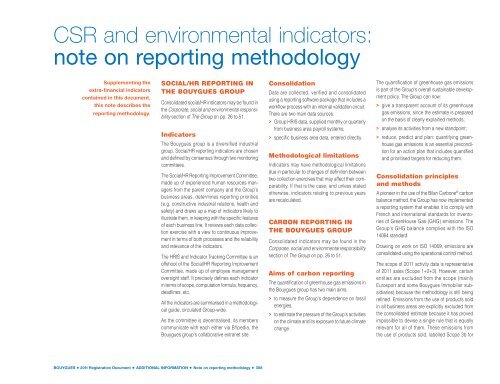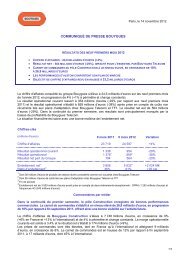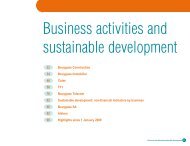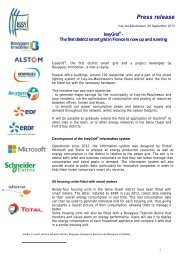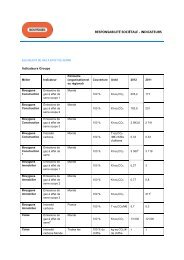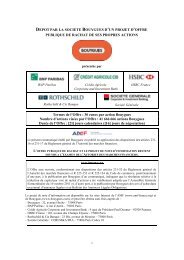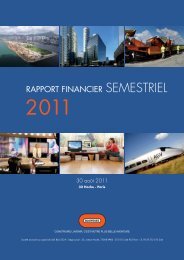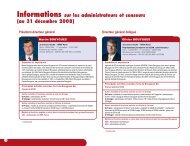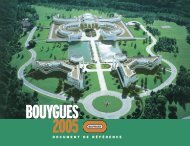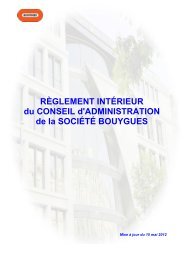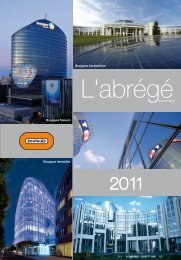Registration Document BOUYGUES
Registration Document BOUYGUES
Registration Document BOUYGUES
You also want an ePaper? Increase the reach of your titles
YUMPU automatically turns print PDFs into web optimized ePapers that Google loves.
CSR and environmental indicators:<br />
note on reporting methodology<br />
Supplementing the<br />
extra-financial indicators<br />
contained in this document,<br />
this note describes the<br />
reporting methodology.<br />
SOCIAL/HR REPORTING IN<br />
THE <strong>BOUYGUES</strong> GROUP<br />
Consolidated social/HR indicators may be found in<br />
the Corporate, social and environmental responsibility<br />
section of The Group on pp. 26 to 51.<br />
Indicators<br />
The Bouygues group is a diversified industrial<br />
group. Social/HR reporting indicators are chosen<br />
and defined by consensus through two monitoring<br />
committees.<br />
The Social/HR Reporting Improvement Committee,<br />
made up of experienced human resources managers<br />
from the parent company and the Group's<br />
business areas, determines reporting priorities<br />
(e.g. constructive industrial relations, health and<br />
safety) and draws up a map of indicators likely to<br />
illustrate them, in keeping with the specific features<br />
of each business line. It reviews each data collection<br />
exercise with a view to continuous improvement<br />
in terms of both processes and the reliability<br />
and relevance of the indicators.<br />
The HRIS and Indicator Tracking Committee is an<br />
offshoot of the Social/HR Reporting Improvement<br />
Committee, made up of employee management<br />
oversight staff. It precisely defines each indicator<br />
in terms of scope, computation formula, frequency,<br />
deadlines, etc.<br />
All the indicators are summarised in a methodological<br />
guide, circulated Group-wide.<br />
As the committee is decentralised, its members<br />
communicate with each either via BYpedia, the<br />
Bouygues group's collaborative extranet site.<br />
Consolidation<br />
Data are collected, verified and consolidated<br />
using a reporting software package that includes a<br />
workflow process with an internal validation circuit.<br />
There are two main data sources:<br />
> Group HRIS data, supplied monthly or quarterly<br />
from business area payroll systems;<br />
> specific business area data, entered directly.<br />
Methodological limitations<br />
Indicators may have methodological limitations<br />
due in particular to changes of definition between<br />
two collection exercises that may affect their comparability.<br />
If that is the case, and unless stated<br />
otherwise, indicators relating to previous years<br />
are recalculated.<br />
CARBON REPORTING IN<br />
THE <strong>BOUYGUES</strong> GROUP<br />
Consolidated indicators may be found in the<br />
Corporate, social and environmental responsibility<br />
section of The Group on pp. 26 to 51.<br />
Aims of carbon reporting<br />
The quantification of greenhouse gas emissions in<br />
the Bouygues group has two main aims:<br />
> to measure the Group's dependence on fossil<br />
energies,<br />
> to estimate the pressure of the Group's activities<br />
on the climate and its exposure to future climate<br />
change.<br />
The quantification of greenhouse gas emissions<br />
is part of the Group's overall sustainable development<br />
policy. The Group can now:<br />
> give a transparent account of its greenhouse<br />
gas emissions, since the estimate is prepared<br />
on the basis of clearly explained methods;<br />
> analyse its activities from a new standpoint;<br />
> reduce, predict and plan: quantifying greenhouse<br />
gas emissions is an essential precondition<br />
for an action plan that includes quantified<br />
and prioritised targets for reducing them.<br />
Consolidation principles<br />
and methods<br />
A pioneer in the use of the Bilan Carbone ® carbon<br />
balance method, the Group has now implemented<br />
a reporting system that enables it to comply with<br />
French and international standards for inventories<br />
of GreenHouse Gas (GHG) emissions. The<br />
Group's GHG balance complies with the ISO<br />
14064 standard.<br />
Drawing on work on ISO 14069, emissions are<br />
consolidated using the operational control method.<br />
The scope of 2011 activity data is representative<br />
of 2011 sales (Scope 1+2+3). However, certain<br />
entities are excluded from the scope (mainly<br />
Eurosport and some Bouygues Immobilier subsidiaries)<br />
because the methodology is still being<br />
refined. Emissions from the use of products sold<br />
in all business areas are explicitly excluded from<br />
the consolidated estimate because it has proved<br />
impossible to devise a single rule that is equally<br />
relevant for all of them. These emissions from<br />
the use of products sold, labelled Scope 3b for<br />
<strong>BOUYGUES</strong> • 2011 <strong>Registration</strong> <strong>Document</strong> • ADDITIONAL INFORMATION • Note on reporting methodology • 308


